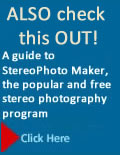3D Digital Picture Frames
There are a number of ways to display 3D images on digital frames. If you have a 2D frame you can convert your stereo pairs, and even your movies, to anaglyphs so people can view them in 3D on the frame wearing anaglyph glasses. You can also display stills as side-by-side pairs for parallel or cross freeviewing. However, you may also want to consider an autostereoscopic 3D frame, most of which use parallax barriers. To see the 3D effect, the two images in a stereo pair are interleaved by software in the frame so both images fit into the horizontal space normally used by one. For this reason a frame with a native resolution of 800 × 600 pixels is cut in half to 400 x 600 when displaying 3D images.
- Because autostereoscopic frames are not usually multiview, the 3D effect is only obvious from certain angles.
- You should be able to shift the images horizontally to adjust the position of the stereo window.
- Most frames support MP3 music and 3D HD video (720 or 1080) in a variety of formats.
- With the Fuji Real 3D cameras you can transfer images to the frame directly from the camera via infrared. You can also use FinePix Studio to copy photos from the computer to the frame.
FRAME FEATURES
- Some 3D frames contain software that can convert 2D images to 3D.
- Some frames use the Android operating system so they can run third-party apps.

PICTURETOWN
Nikon has launched a site called my Picturetown 3D that offers 3D image conversion over the Internet for viewing of 3D images on a dedicated 3D digital photo frame. At the time of this writing it seems to be only in Japanese http://3d.mypicturetown.com/
MIRROR SPLIT
You can use what YouTube calls mirror-split to watch 3D movies on a 2D picture frame as discussed in the Mirror Viewers section of Chapter 1.
|

